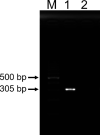Cryptosporidium parvum infection and management-based risk factors of dairy calves in Taiwan
- PMID: 34645725
- PMCID: PMC8762416
- DOI: 10.1292/jvms.21-0366
Cryptosporidium parvum infection and management-based risk factors of dairy calves in Taiwan
Abstract
Cryptosporidiosis is one of the major causes of diarrhea in calves. Cryptosporidium parvum is considered the most important calf diarrhea pathogen in the Cryptosporidium species. Not only could infected calves spread C. parvum, but infected adult cattle could also shed oocysts. The objectives of this study were (1) to investigate the prevalence of C. parvum in dairy herds in Taiwan, including calves, the dams in delivery enclosure, the floor, and the drinking water; (2) to clarify the relationship of diarrhea, management, and C. parvum infection. Twenty dairy herds in Taiwan were selected by random sampling, including 226 calves and 198 dams, and other environmental samples were collected. A questionnaire was filled out by the farm owners to collect information regarding the management of calves and the delivery enclosure. Hierarchical logistic regression was used to analyze the risk factors for C. parvum infection. The prevalence of C. parvum infection in calves was 26.5% (60/226), while in dams, it was 19.7% (39/198). The C. parvum infection in calves increased with environmental contamination of C. parvum and clinical signs of diarrhea, while it decreased with a yard provided in the delivery enclosure. In conclusion, the management of the delivery enclosure appears to be more important for preventing cryptosporidiosis in calves in Taiwan.
Keywords: Cryptosporidium parvum; dairy calf; delivery enclosure; diarrhea; management.
Conflict of interest statement
The authors declare that there is no conflict of interest.
Figures



References
-
- Allison P. D.1999. Multiple regression: A primer. Pine Forge Press, Thousand Oaks.
-
- Bates D., Mächler M., Bolker B., Walker S.2015. Fitting linear mixed-effects models using lme4. J. Stat. Softw. 67: 1–48. doi: 10.18637/jss.v067.i01 - DOI

